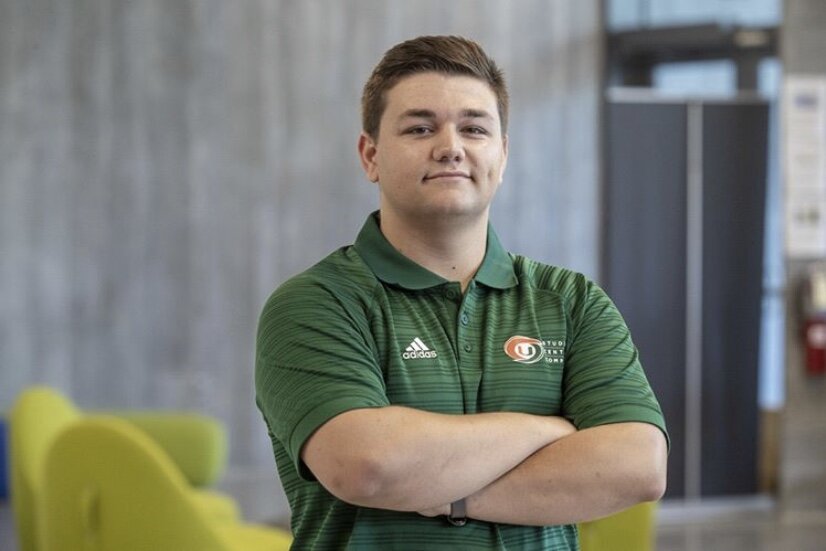Living with Water: The Miami Team
Photo courtesy BBC
The University of Miami School of Architecture team, one of five leading design schools participating in the Envision Resilience Nantucket Challenge, is no stranger to sea level rise. The National Oceanic and Atmospheric Administration (NOAA) high scenario projects (in inches relative to mean sea level in 2000) that by 2040, Miami could see 21 more inches of sea level. By 2100, that increases to 120 inches, according to the Unified Sea Level Rise Projection: 2019 Update.
“If you are at University of Miami School of Architecture and are not yet familiar with sea level rise, you haven’t been going to class,” said student Tanner Wall, of the University of Miami cohort. “We are thinking about coastal resilience in every single class we take, it’s a core part of the curriculum.”
The team representing Miami in the Envision Resilience Nantucket Challenge is using their experience with rising seas in their own region, as well as an in-depth coastal urban resilience foundation, to consider how the island of Nantucket might adapt.
“There are several similarities, as well as contrasts, between Miami-Dade and Nantucket, which make a comparative analysis interesting—from their tourism and port-based economies, iconic National Register Historic Districts and their Atlantic Ocean-driven climate realities, to their diverse scales, socio-economic conditions and terrain and, for these reasons, I wanted our students to be a part of this rich learning experience,” said Sonia Chao, Research Associate Professor and faculty lead for the University of Miami’s team. Sonia is the director of the School of Architecture’s outreach arm, the Center for Urban and Community Design (CUCD) and is co-director of its newly launched interdisciplinary Master of Professional Science in Urban Sustainability and Resilience (MPS/US&R) program.
“We frequently use the South Florida region as our living laboratory. We are sitting at the Achilles heel of coastal resilience along the eastern seaboard. ”
The School of Architecture recently modified its strategic plan, creating a holistic coastal resiliency curriculum. As Sonia explained, the University of Miami School of Architecture’s Strategic Orientation Plan places ‘coastal urban resilience’ at the center of graduate and undergraduate curriculums so that all UM students have, at the very least, a general awareness of such topics from early on in their studies. Additionally, seeing the need to break down academic silos and better prepare future climate leaders, “UM’s Architecture School partnered with the College of Arts & Sciences’ Geography department to develop this novel program. After its initial required core courses, the program offers students an opportunity to select from courses across our various academic units, in this manner crafting the focus of their studies. Furthermore, our inaugural class of MPS/US&R students have quite diverse backgrounds-from architecture and planning to agriculture and engineering. Two of our MPS/US&R students are a part of the small cohort from UM participating in the Envision Resilience Nantucket Challenge,” said Sonia.
“We frequently use the South Florida region as our living laboratory,” she said. “We are sitting at the Achilles heel of coastal resilience along the eastern seaboard. Miami-Dade is a really dynamic region for students to be studying in because the learning is tangible—whether it be interning at a municipal or County Resilience Office, working on interdisciplinary funded research in the field, documenting historic building vulnerabilities on the ground or writing academic papers related to our current socio-economic issues. They’re not just reading charts and data about these issues and solutions, they are witnessing it firsthand and directly engaging with climate, sustainability and resilience leaders from across the Southeast and Caribbean region.”
Sonia has guided the UM students participating in the Nantucket Challenge “to be ‘hyperlocal’ both in their analysis and proposals, starting by understanding the DNA of this unique historic place.”
The University of Miami team during the spring 2021 design studio.
Sonia has led more than 40 design studio charrettes during her tenure as a professor. She writes and teaches in the area of sustainable architecture and urbanism, resilient design, and historic preservation in the subtropics. Her scholarship explores the intersection between historic preservation, historic places and resilient design. Over the years, she has received numerous grants from public agencies, such as the National Science Foundation, the National Endowment for the Arts, from private foundations including the W.K. Kellogg Foundation, as well as contracts from regional and local governments. Prof. Chao and her team at the UM/CUCD are currently completing user-friendly pamphlets for the City of Miami and for the City of Miami Beach, to introduce historic property owners to issues and ‘sympathetic’ climate adaptation methods for the short and long term.
She was recently recognized by the Dean of the UM School of Architecture, Rodolphe el-Khoury, for her role in the School’s “Sub-Tropical and Tropical Coastal Resilience: Social, Economic, and Physical Adaptations in South Florida and the Caribbean” symposium on April 7, the News@TheU reported. During the virtual event, el-Khoury highlighted Sonia, “whose work has long probed the intersection of climate change, resilient design, and historic preservation and is shaping the School’s curriculum in coastal urban resilience.”
“Learning about Nantucket’s rich history, the tight-knit community, as well as the strong sense of place through aesthetics has given me a new perspective of resilient design. Not only do we need to protect our coastal areas, but that we need to do so in a way that preserves the existing community and urban fabric.””
That intersection of climate change, resilient design and historic preservation is helping to drive the work of the Miami team this semester, made up of undergraduate students Tanner Wall and Thomas Long, and graduate students Camilla Zablah Jimenez and Paula Christina Viala, both in their first year of the school’s new interdisciplinary Master of Professional Science in Urban Sustainability and Resilience program.
“The Envision Resilience Nantucket Challenge has for me re-emphasized place-based design,” said Thomas. “Learning about Nantucket's rich history, the tight-knit community, as well as the strong sense of place through aesthetics has given me a new perspective of resilient design. Not only do we need to protect our coastal areas, but that we need to do so in a way that preserves the existing community and urban fabric.”
Three of the four students took part in Sonia’s three-credit fall course “An Introduction to Resilient Building and Community Design,” in which they began their analysis of Nantucket. The fall course was composed of 18 students who, along with Graduate Teaching Assistant of the course Michael M. Ganom, completed extensive research and schematic design for the Challenge. Equipped with the foundation of research established in the fall, Tanner, Thomas, Camila and Paula Christina continued with Sonia’s three credit “Special Problems” course this semester.
“I am hoping that the solutions we propose are suitable for Nantucket and that we have truly understood the unique characteristics and challenges that relate specifically to this historic place.”
“Each student from our fall course brought initial perspectives from their different backgrounds and we took that opportunity to analyze each student’s hometown and the resilience strategies being implemented there,” said Michael. “We learned a lot from that exercise about adaptation strategies in different settings, including the Caribbean, the U.S. , Europe, Latin America, Asia, and Florida too. During the final third of the semester, we looked at Nantucket’s history, assets and challenges to adaptation.”
A theme the group kept coming back to was the design strategy of resilience that is both smart and beautiful, benefiting the community it serves in more ways than one.
“Adapting to sea level rise and climate change is not a blanket solution that can be applied to every city facing similar challenges in the same way. You need to understand the history and propose solutions that apply to each place specifically,” said Camilla. “I am hoping that the solutions we propose are suitable for Nantucket and that we have truly understood the unique characteristics and challenges that relate specifically to this historic place.”
“Though it shares many similarities with Miami, Nantucket is a new challenge, a new site,” said Tanner. “Our thinking is, let’s merge what we already know with what we’ve learned here. In my lifetime, I see myself coming back to Miami, and finding that the people that have stayed, have adapted to the conditions of sea level rise, learning to live with the water. I see Nantucket in a similar way. . . this Challenge has given me insight on what we will truly face in the future. We can "hold off" the water for a little while longer, so long-term plans can be put into place in the short-term, but soon, we will have to formulate ways to adapt or retreat. I have accepted the future conditions that come from climate change, and I believe we are in our last 30-year building cycle, as we know it, for cities on the coastline.”
Adaptation is not only the theme of the Challenge, but the theme of the last year under a global pandemic. Participating Challenge teams have continued to impress the Nantucket advisors with their work, despite the large majority of students never yet having stepped foot on the island.
And, this team feels as though they have seen, smelled, experienced Nantucket, at least virtually.
“The lecture series has been top notch and comprehensive while the weekly meetings with local experts have been equally insightful, both serving to nourish the formation of the resilient design concepts,” said Sonia. “We are looking forward to visiting Nantucket soon and to sharing the UM team’s proposals with the local community. Moreover, we hope they prove useful to the residents of the “Little Grey Lady of the Sea.”
The team will be one of five travelling to the island in early June to present their designs to the Nantucket community. Please visit our events page to learn more.
Camila Zablah Jimenez is an urban planner with a background in traditional architecture. She is currently pursuing a Master of Professional Science in Urban Sustainability and Resilience '22 from the University of Miami.
Thomas Long is a first-generation student at the University of Miami, currently in his fourth undergraduate year at the Miami School of Architecture. Thomas has always had a passion for both resilience and sustainability when designing. When the opportunity to participate in the Envision Resilience Nantucket Challenge, he jumped at it and made sure the school could get a group together in order to participate.
Paula Christina Viala is passionate about helping cities become more sustainable, resilient and equitable. Her passion for sustainability blossomed in her undergraduate years in the pursuit of her civil engineering bachelor’s, and throughout her professional career. A certified LEED GREEN Associate professional, Christina is constantly expanding her repertoire of sustainability and resilience practices. She is currently enrolled in the Master of Urban Sustainability and Resilience at the University of Miami and is also a Research Assistant in the program. Her interests include sustainable development in the developing world, effective urban governance, and non-profit management. The Envision Resilience Nantucket Challenge presented a unique opportunity to tackle a unique resilience issue while getting invaluable information from industry experts and academic professionals.
Tanner Wall, of St. Petersburg, Florida, is a 5th year architecture student at the University of Miami, with a minor in Art. He is currently interning at Harvard Jolly Architecture, where he works on a variety of commercial projects. He joined the Miami team for the Envision Resilience Nantucket Challenge through a 3-credit architecture elective.







